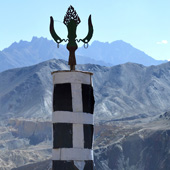Design Resource
The Lamayuru Monastery
Life, Learnings and More from Ladakh
by
The Lamayuru Monastery is located atop a hill, its height offers interesting views of the landscape and a birdseye view into the local houses.
The monastery belonging to the red hat sect of Buddhism, has an assembly hall, the Avalokitesvara temple, residences of some 30 monks, a monastery school for the little monks and meditation halls above in the mountains, which attract a fair number of tourists from overseas.
A trishul sits above the roof of the monastery temple, signifying the sanctity of the space below. The entrance of the monastery like every other traditional Buddhist monastery has a painting on the wall depicting the four kings. These four kings are the protectors of the four cardinal directions. Also painted upon the walls is an elaborate painting of the dharmachakra, which sums up the meaning of Buddhism in a single visual.
The interiors are vibrantly painted in different colors each maintaining a certain symbolism. By meditating on these colors, it is believed that spiritual transformations can be achieved.
The walls around the skylight, that remains the only source of light within a gonpa, have the 21 Buddha's painted above in different mudras, and the 1000 Buddha's painted below.
Concealed within the temple is a cave where the great Guru Naropa’s is said to have meditated, it dates back to the 10th century. The monks here are well versed in the art of Mask Dances. And the annual festival of Yuru Kabgyat taking place in June is a major attraction. The monks spend about a month preparing masks and designs for the ‘torma’ or offerings made from barley and yak butter for the festival. The little monks in training spend their time praying, learning subjects, performing daily chores, carrying out rituals and playing outdoor games at the monastery school.







































